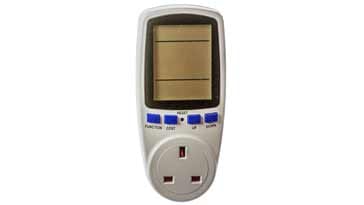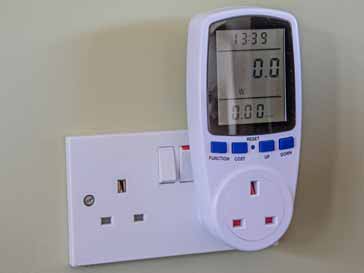Plug-In Power Meter: Electricity Usage Monitor
It is possible to measure the power being consumed by different electrical items by using a plug in power meter / electricity usage monitor: plug in the item to be tested - simple, safe & effective.
Energy Saving Technology Includes:
Home energy saving technology
Guidelines for home energy saving
List of energy saving gadgets
How to choose best LED light bulbs
Plug-in timer switches
Plug-in power meter / usage monitor
When looking at home energy saving technology, one very useful, but low cost item is a plug in power meter or energy usage monitor.
These devices will soon pay for the cost outlay in letting you understand what energy an item is using and thereby enable you to use it more effectively. In this way it is possible to reduce energy costs as well as reducing your carbon footprint.
It us surprising quite how much energy some devices use, especially if they are left running or in standby when not in use. Although the actual power may be small, when totalled up over a day, week, month etc, it soon mounts up.

What is a plug-in power meter / electricity usage monitor
Measuring the power consumed by an electrical device is not always easy. Years ago it would have required an expensive piece of professional test equipment or the use of a multimeter. Using the multimeter would not have been easy because it would have required wiring the meter into circuit, and with mains voltages this might not always have been safe or easy.
Today there are many different types of electricity usage monitor / power meter, although they tend to fall into one of two main types.
Stand-alone plug-in power meter: These items plug into the mains power-line outlet instead of the item you want to test, and then this item is plugged into the monitor. In this way, this type of electricity usage monitor or plug-in power meter sits between the mains power source and the item being monitored. This is a safe and easy way of connecting the power meter in circuit.
These energy usage monitors take the basic readings of voltage and current and can convert these into a variety of useful quantities to monitor.

Typical mains power meter for testing power consumption of domestic appliances Different monitors will be able to provide different measurements. Often they will give continuous readings for voltage, current, power in kWh, and soem may even give power factor and the like.
In addition to the direct readings these energy monitors are also able to work out the cost of various appliances. It is possible to enter, typically one or two cost rates, e.g. standard rate and off-peak rate, and then this can be used to calculate the cost of running the device over a given period of time.
Smartphone based electricity usage monitor: Although the stand alone energy monitors are very useful and very cost effective, some people may want a more advanced system. It is possible to obtain systems that use several energy monitors that use a smartphone to display the information using an App. They may also have a number of sensors that can monitor different appliances.
Using a comprehensive electricity usage monitor like this, it is possible to gain a more detailed view of a number of usage points around the home. This type of system might be described as a smart home energy monitor.
These more advanced systems may use clip on monitors that connect to a central unit that then sends data to the smartphone. The clip on sensors just clip around the mains lead for the particular item being monitored, and they can sense the current, and hence the power being used.
Whatever type of plug-in-monitor or electricity usage monitor, it is possible to understand the usage of electricity and thereby optimise the usage. Without this sort of information, it is only possible to guess at what is best to do.
How to buy best energy monitor / plug-in power meter
There are several points to consider when looking to buy an electricity usage monitor / plug-in power meter.
There is a very wide selection of different meters / monitors in the market representing the growing demand for these units.
There are several points to consider:
Stand-alone or multipoint app-driven: One of the first decisions to be made is how far you want to go with monitoring the electricity usage.
For many people, the stand-alone plug-in power meter will be quite sufficient. It will be able to be used to measure the electricity usage of the various items, and then their use can be optimised, before moving on to the next item. For this type of usage, the stand alone plug-in power meter is quite satisfactory.
For other people, it will be necessary to have continuous monitoring of many more points on an ongoing basis. For this type of usage a smart home energy monitor might be more appropriate.
Ensure correct connector type: As plug-in-power meters can be used in many countries around the globe, where many different types of mains connector can be used, it is necessary to ensure that a monitor with the correct connector type is bought.
If they are being bought on a local shop for local usage, there should not be a problem, but if there is any chance of there being a different connector type being used, then it is best to check.
Measurements & information displayed: Electricity usage monitors of all types can measure and display a variety of parameters. Check that any particular monitor will give you the information needed. A typical meter or monitor may be able to provide information about such parameters as: Power (W), Energy (kWh), Current (A), Voltage (V), Power Factor, Cost, Maximum Power, Minimum Power, etc. Ensure it provides what is needed.
Accuracy: Many of these meters and monitors are essential domestic instruments and they will not be perfectly accurate. Figures for some of these plug-in power meters and electricity usage monitors claim accuracy levels of ±2%, although this may be a bit optimistic. Best to take the figures given as a good guide.
Maximum handling: Both the plug-in power meters and also the electricity usage monitors that use the clip of the wire sensors will have a maximum current or power they can handle. Typically this may be around 15 amps or 3.5kW. In most domestic instances it is unlikely this will be exceeded, but in case very high current appliances need to be monitored, check the ratings against the requirements.
Reliability: It is always best to check the reviews for the particular monitor in question to ensure that it is not only reliable, but that it works in a sensible fashion - it is easy to use.
Cost: Cost of the monitor can be a major deciding factor. If the deciding factor is to gain an overall cost saving, the lower the cost the better. In this case a stand alone energy monitor might be better as the individual electrical items can be monitored and their usage can be optimised, before moving on to the next. This can give energy cost savings while also minimising energy usage.
For anyone wanting a much more comprehensive system, the cost is obviously going to be greater and this will need to be considered from the outset.
It is worth looking at all the options available, seeing the reviews of the individual items available and making a decision on the best one to purchase.
Using a plug in power meter or energy usage monitor, it is possible to gain a very much better idea of what energy is being used. In this way it is possible to manage any energy use much better, i.e. from a viewpoint of seeing the actual measurements of the usage, rather than guessing what it might be.
 Written by Ian Poole .
Written by Ian Poole .
Experienced electronics engineer and author.
More Eco / Green Engineering Topics:
Smart meter technology
Solar electricity generation
Smart grid
Home energy saving technology
LED lights
Energy saving guidelines
Return to Eco / Green Engineering menu . . .



